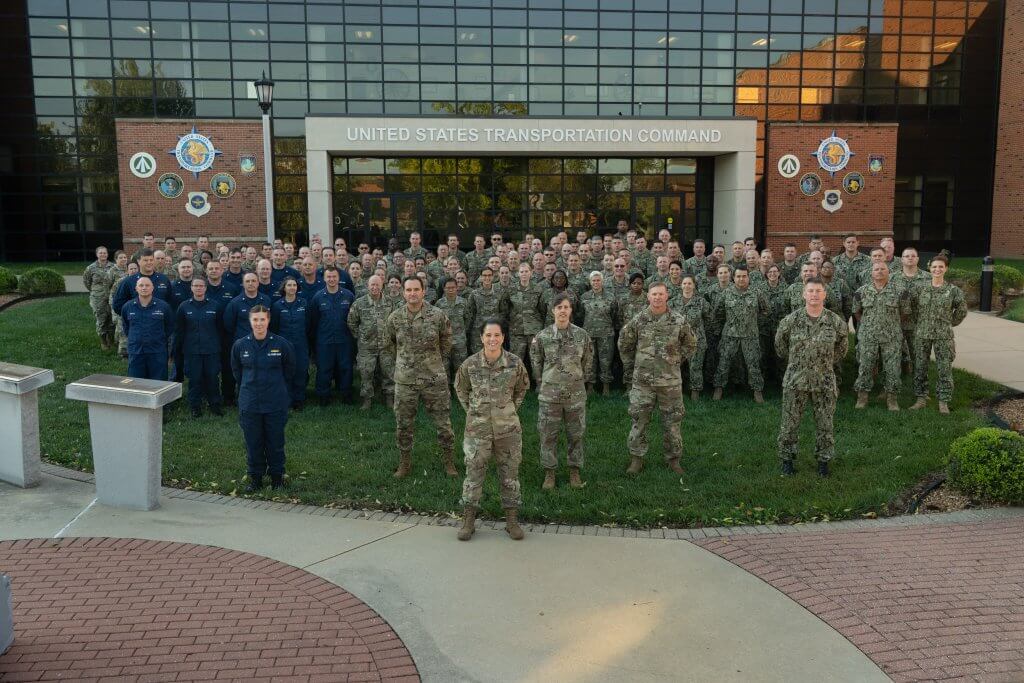As Ukrainians awoke to the Russian military invading their homeland on Feb. 24, 2022, Coast Guard Reserve Cmdr. Shawn Nesser was on drill, about to become involved in the United States’ now monthslong effort to support Ukraine and its allies.
“It made for a very busy drill weekend, let’s put it that way,” said Nesser, who is among those in TRANSCOM’S Joint Transportation Reserve Unit (JTRU) who have been activated over the past year in response to Russia’s aggression.
U.S. Army Reserve Maj. Gen. Cheryn Fasano, JTRU’s commander, said in a statement provided to AmeriForce Media that the reserve component has an “unmatched advantage” under the TRANSCOM umbrella.
“We can immediately scale up our manpower and efforts from an all-volunteer force with a phone call,” Fasano said.
‘Ebbing and flowing’
The JTRU response to Ukraine support efforts has fluctuated since February 2022 “based on demand,” according to Navy Reserve Cmdr. John Pierczynski.
“We’re really good at ebbing and flowing and surging as necessary,” said Pierczynski, who was on monthlong AT orders from mid-March to mid-April.
As of January 2023 – the most recent data available – U.S. Transportation Command had provided nearly 950 flights, 57 vessels, 143 trains and more than 5,500 trucks carrying, among other items, 202 million small-arms rounds, more than 14,000 small arms and thousands of helmets and body armor sets.
Marine Corps Reserve Maj. Kevin Roepe said there were a lot of support requests from active duty as its “op tempo started picking up quite a bit.” With a week or two notice, Roepe said, he could make arrangements at his civilian employer and respond to such requests.
His role in this activation was to take “daily routine” tasks off the active-duty component so they could focus on Ukraine, he said.
Nesser, who works in the global operations center, said the Ukraine response fit into the “overall ebb and flow” of the global military transportation network.
“From our perspective, it doesn’t really matter if you’re [an] active-duty military member, civilian or reservists,” Nesser said. “Our leadership, they don’t care, ‘Are you active duty, civilian or reservist?’ They just want the answers and want their information and that’s basically how we operate.”
To that point, Piercyzynski said that when he demobilized from the COVID-19 response, a lot of people were surprised he was a reservist.
“They just thought I was another active-duty person there for a full tour,” Piercyznski said. “And that’s what we train to do, is to be indistinguishable when we’re there from the active component.”
Bringing diversity to Ukraine mission
While reservists like Roepe took on day-to-day responsibilities, Pierczynski did the opposite.
“What I was able to do was take on a lot of their Ukraine operations functions and work those longer hours,” Pierczynski said, “work the nights, work a couple of weekends, which allowed those guys [on active duty] to get the night off to go to their kids’ baseball game, get the weekend off to go spend with the family, to get that time off to get that deep breath so that they were able to reengage as necessary.”
Reservists also bring “a little bit of diversity” to the active-duty force because of their work in various industries, whether civilian, government or the private sector, Nesser said.
“The thing that makes us interesting is that while our adversaries have to spin people up with a lot of training, just for little bit of investment of one weekend a month, two weeks a year, we’re up and running, adding instantly to the mission,” he said.
Pierczynski’s role in supporting Ukraine also became a teaching moment for his 8 ½-year-old daughter.
“We used that as an opportunity to have a conversation with her about what’s going on in the world, and there are some people who are not very nice out there doing some not very nice things and others suffering as a result of that,” Pierczynski said.
He also said he highlighted that it’s possible to help another country without ever setting foot there.
“People think of the U.S. military always being storming the beaches of Normandy and everything’s a firefight,” Pierczynski said. “But it’s not. In many cases, the help we’re providing is disaster relief after a hurricane or natural disaster.”
Marathon, not a sprint
Army Reserve Capt. Kristen Minda said compared to COVID-19 orders and the Afghanistan Noncombatant Evacuation Operations (NEO), Ukraine support has not been as demanding.
“During the NEO, we were going 24-hour operations, fueling a ton of questions and providing reports and analysis,” Minda said. “It was really, really busy. Now I’m at orders again in that same area, and we are less busy during this involvement … than we were during NEO largely because it’s a significantly lighter patient load, and we aren’t rapidly reacting to battle injuries and that sort of thing.”
Pierczynski also was mobilized around the same time as Minda during the COVID-19 response and supported Operation Allies Welcome. The responses, he said, were “three different animals.”
“COVID was just a multiheaded dragon that every time you think you understood it, something changed. Nobody really knew what was going on,” Pierczynski said. “And that’s not just TRANSCOM, that’s globally.”
The Afghanistan withdrawal was a sprint, Pierczynski said, with a “finite amount of time” to evacuate people from the country.
Ukraine though, is a marathon.
“Once that starting gun went off, they came out of the gate running … [and we were] able to give them that breath, able to maintain that long distance pace for that marathon that is Ukraine, and as they built that routine, it became much more easy for them to do,” Pierczynski said.
Editor’s note: An earlier version of this article incorrectly stated that JTRU alone provided flights, vessels, trains, and other items, in support of Ukraine’s efforts. This has since been clarified.

